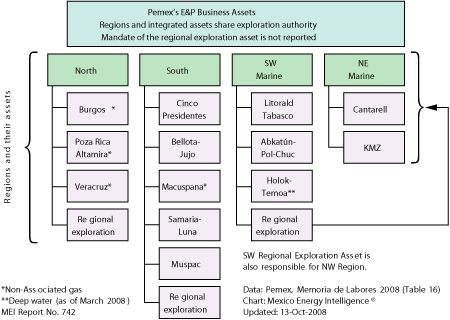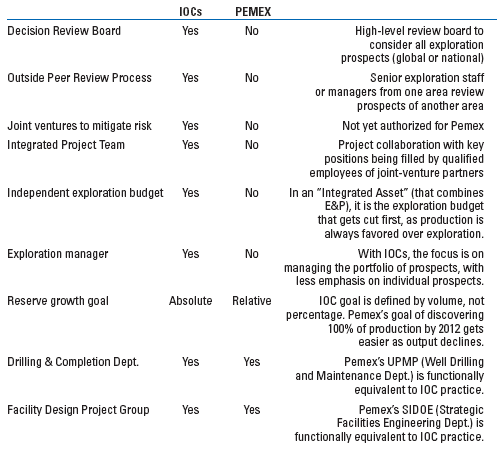The recent news is exciting to be sure, but it will take a while to set up the regulatory and structural framework to make participation by IOCs a reality.
George Baker, Publisher, Energia
There is good news and bad news coming out of Mexico’s oil sector: The good news is that the government and the sharply divided Congress have been able to agree, finally, on an oil reform package. The package makes progress on three fronts: First, it seeks to dramatically upgrade public oversight of the famously independent national oil company, Pemex. Second, it seeks to strengthen corporate governance in Pemex by restructuring and expanding the corporate board of directors and by increasing the authority and responsibility of the presidential appointee who is the chief executive. Third, it seeks to give Pemex greater flexibility in the design of contractual models for goods and services, including incentive (or performance) bonuses.
The bad news is about what was omitted from the reform package: specific measures to improve exploration, explicit measures to involve the expertise of oil companies in deepwater E&P, and making the tenure of the corporate director general at the pleasure of the Pemex board, not at the pleasure of presidential politics.
This article briefly examines three topics: the origin of the current upstream controversy in Mexico, the oil reform package and management of exploration in Pemex. At the end, we consider measures that were omitted from the reform package.
ORIGIN OF CONTROVERSY
The prescient Mexican lawmakers who were drafting a new constitution in 1916 realized that the legal model that had been developed centuries before by the Spanish Crown regarding mineral rights would serve Mexico better than the Mining Code of 1892, which gave those rights to the surface owner. The Spanish idea had two parts: the molecules of all minerals belong to the Crown, but their commercial exploitation could be done by anyone with royal permission in the form of a concession. This twin idea was embodied in Article 27 of the Mexican constitution and is the norm worldwide in modernized forms, with the one exception of privately owned acreage in the United States.
Oil companies were slow to appreciate the subtlety of this Hispano-Mexican legal invention. The companies feared that any undermining of the principle of surface ownership with full mineral rights would destroy the industry; they did not anticipate that the application of this principle would unleash corporate and technological creativity on a grand scale. Thus blinded, they resisted Mexican attempts to implement Article 27 of the constitution. The result was the wholesale nationalization of the oil industry during Easter Week of 1938.
Looking back, the oil companies did not know what they were doing-but neither did the Mexican government. The companies did not foresee the possibility of dozens of contractual forms that made commercial sense under the new system. For its part, the government oversold the nationalization and thus imprinted “us versus them” in the Mexican national psyche, not realizing that it would be essential for the development of Mexico’s oil industry to maintain an efficient interface between a local, Mexican oil company and the international oil industry. True, for a time, lawmakers left the door open for oil company participation in the upstream and midstream: Articles 7 and 8 of the Petroleum Law of 1941 stated that private parties may engage in exploration and production (as a minority partner with the State), and be paid in cash or as a percentage of production.
In 1958, however, lawmakers reversed course, and a new Petroleum Law prohibited, in Article 6, payment as a share of production. By 1970, the half-dozen risk contracts then in force were terminated, and no lawmaker since then has dared to reopen the subject.
In 1999, then-Governor Vicente Fox of Guanajuato told the New York-based Council on Foreign Relations in a meeting with council members that he favored the privatization of Pemex. The reaction in Mexico was swift: Henceforth, no photograph of Mr. Fox would appear in the public media without the Pemex logo in the background. During his presidency, Mr. Fox was repeatedly accused of wanting to sell off Pemex. Unfortunately, Mr. Fox did not choose to use the tremendous power of his popular mandate in 2000 to change the course or rhetoric of the oil industry.
With the election of Felipe Calderón as Fox’s successor in 2006, the opposition exploited the national sensitivity about the oil industry, renewing the accusation that the government wanted to privatize Pemex. President Calderón’s party, the PAN, did not have a majority in the Senate, but, to his advantage, the second-largest faction there is the PRI, with the PRD party being third. In the summer of 2008, there were 21⁄2 months of testimony over what should be done to “strengthen Pemex,” as the expression went. The negotiations in the fall were between the PAN and the PRI, hoping to outmaneuver the PRD and other left-leaning parties.
THE OIL REFORM OF 2008
The oil reform was, in three equal parts, an attempt to strengthen public oversight of Pemex, an attempt to strengthen corporate governance inside Pemex, and an attempt to make Pemex’s and the government’s interface with the international oil industry more efficient. The reform package gave greater authority to the Energy Ministry (SENER), including new upstream advisory boards. A derivative-like investment instrument was invented, but only for Mexican citizens. The instrument, called a “Citizen Bond,” would not convey ownership or voting rights, but it would create an outside constituency to which Pemex would have to provide timely and transparent reports.
Pemex’s corporate governance would be strengthened by a restructured and enlarged board of directors, and by an expanded redefinition of the authority and mandate of the director general of Pemex Corporate. The board, in addition to four new “professional” members, would have several standing committees on compensation, performance evaluation and-most importantly-procurement.
The reform package would also make Pemex’s relationship to the international oil industry more efficient: A controversial measure proposed by the government and approved into law was the performance, or incentive, contract. The law provides that Pemex may pay a contractor more than the amount originally negotiated under certain conditions.
Once the terms of the new legislation were known, the sentiment that was expressed by many in Mexico was this: “The oil reform that was passed was not the best, it was not the one that we needed, but, at least, something was done in the name of reform.”
EXPLORATION
The interface between Pemex and the international oil industry is somewhat improved by the reform package, but there is nothing, specifically, that will help Pemex or Mexico move into a serious program of deepwater exploration and development.
There were many consequences of the decision of Mexican lawmakers in 1958 to exclude paying oil companies with a share of production. One of these consequences was that Pemex would fall into the open arms of the oilfield service companies. Within a few years, a joint venture between Pemex and Schlumberger would be established, Compañía Mexicana de Exploraciones, S.A. de C.V. (www.comesa.org.mx), and Schlumberger would come to be the service provider of choice (and Pemex would become its principal client, worldwide).
Another consequence would be that Pemex, because it was disconnected from innovations in organization, management and technology as practiced by the oil companies, would learn about them secondhand, from service companies or consulting firms. Thus, in 1992, advised by McKinsey & Company, Pemex abandoned the model that had been in place for over 50 years and substituted a model in which each “core business” was established as a separate legal entity, with the headquarters group also established as a separate legal body.
The public record does not show the logic for including the function of exploration with that of production, but the upstream organization that was created was Pemex Exploration & Production (PEP). This was a model that the oil companies had experimented with but would soon abandon, as it delivered poor results, owing principally to the inevitable bias toward production-at the expense of exploration-that a combined mandate would produce.
Pemex, however, went one step further-again following a business model that the oil companies would abandon-and decentralized exploration authority down to the local or regional business units. Pemex called these local units “integral assets,” meaning that responsibility for exploration would be combined with that of production. In 2004, Pemex, recognizing that something was amiss, created a new regional asset dedicated exclusively to exploration. By 2008, there were three regional exploration assets and 13 combined, or integral, assets, Fig. 1.
 |
|
Fig. 1. Pemex’s present structure.
|
|
There is no information in the public record about how the prospect review process is organized, nor about how, within a given region, it is decided if a prospect is to be drilled by the exploration asset or the integral asset. But, however these matters are decided, the decentralized line authority in exploration is at variance with current IOC practices, Table 1.
| TABLE 1. How do PEMEX and IOCs compare in exploration management? (IOCs appear to have a stronger system of checks and balances) |
 |
|
In months of public debate, the topic of the wisdom of Pemex taking on exploration and development in deepwater areas was hotly contested-but not once was the topic of the adequacy of Pemex’s organization for exploration even mentioned.
WHAT WAS OMITTED
The list is very long, and what follows can only be a sample. It has not yet been proposed, for example, to divide up the Mexican side of the Gulf of Mexico into concession blocks, even if, initially, it were only Pemex that would be authorized to explore and develop hydrocarbons. The discussion of cross-border oilfields would be more precise and intelligible if Mexican waters were mapped into 3 x 3-mi blocks. In this connection, it is a hopeful sign that the Energy Ministry is charged with recommending to the Foreign Ministry agreements and treaties for cross-border oilfields (World Oil, August 2007).
There is no realistic way for Pemex to gain the leverage in people, capital and technology to successfully explore in deep water except through association with international oil companies. The government is not yet willing to lead public opinion to a new course of public policy; instead, it chooses the traditional (if sharply questioned) philosophy of Mexican exceptionalism in the upstream.
The reform package stopped short of creating a true upstream regulator. Establishing new commissions or committees in the Energy Ministry will have questionable effect without a serious commitment to establishing a career path for regulators.
These omissions are particularly onerous in the face of declining oil production-Cantarell is below 1.0 million bpd-down over half from its 2.2 million bopd in 2004.
So, as you see, there is good news and bad news coming out of Mexico’s oil patch.
There is every motivation on the Mexican side--that is, from the technical, managerial and economic sides-to promote some form of a PSA in the coming years. IOCs will have to wait for new contractual forms to be issued by a restructured board of directors, as well as for the outcome of the inevitable court challenges to any policy innovation that the government might propose. Meanwhile, close corporate due diligence is called for in relation to policy, legal and political developments.
|
THE AUTHOR
|
| |
George Baker earned a BA and PhD from Duke University, as well as an MA from California State University, Fullerton. He is the author of Mexico’s Petroleum Sector (PennWell) and many articles in energy journals and trade publications in the US and Mexico. Baker is research director of Energia.com, a Houston-based consultancy following Mexican upstream issues.
|
|




